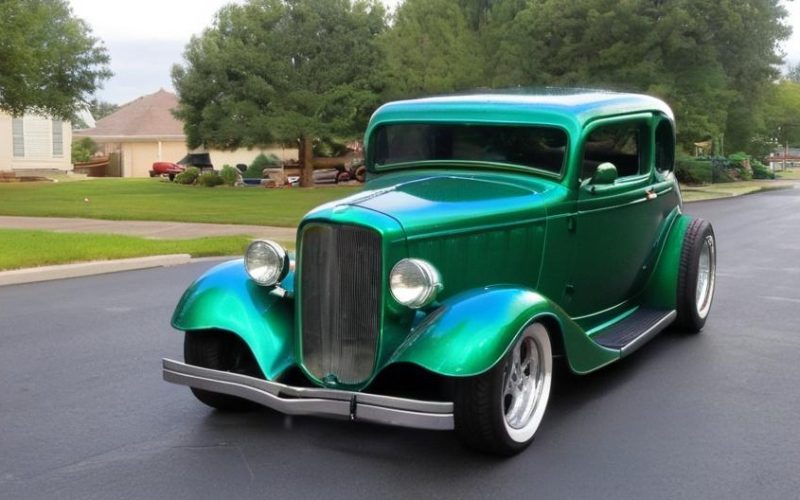Key Take Aways About Fiberglass vs. Steel Bodies for Street Rods
- Steel Bodies: Offer nostalgia, durability, and classic art appeal, but are costly and prone to rust.
- Fiberglass: Lightweight, customizable, and budget-friendly, yet less durable and requires careful handling.
- Cost: Fiberglass is cheaper; steel involves higher fabrication and maintenance expenses.
- Fit and Finish: Steel offers precision; fiberglass demands skilled craftsmanship.
- Community Sentiments: Steel is favored by purists for tradition, while fiberglass is embraced for innovation.
- Conclusion: Both materials have unique benefits, influencing build choice based on personal taste and project goals.

Fiberglass vs. Steel Bodies for Street Rods
In the world of street rodding, everyone’s got a preferred flavor, whether it’s the gleam of a classic steel body or the lightweight charm of fiberglass. Both materials have their loyal fans and distinct quirks, making it all about personal taste and the purpose of the build. Let’s buckle up and dig a little deeper into why folks might choose one over the other.
The Appeal of Steel Bodies
Steel bodies have this undeniable nostalgic vibe. Imagine a time when cars weren’t just vehicles but rolling pieces of art. You see, steel was the material of choice back in the day. This means when you’re working with steel, you’re keeping a piece of history alive. There’s something special about the weight, the way it feels solid when you slam the door shut. It’s like a connecting thread to the past.
Apart from sentimentality, steel’s tough. It can take a bang or two and still look pretty. Not to mention, it lends itself beautifully to rust and patina for that genuine, worn-in look. However, your wallet might feel a bit lighter by the end because steel can be pricey, especially if you’re going for those rare, original panels.
Fiberglass: The Modern Marvel
Not every rod enthusiast is hunting for a trip down memory lane. Some are all about what’s new and efficient. Fiberglass bodies, there’s where the magic happens. They’re light, which means you’re looking at better performance and potentially better fuel efficiency. If you’re all about speed, reducing any extra weight can push you just a bit faster down those quarter-mile strips.
Fiberglass also offers easier customization. You want a wild, unique design? No problem. It’s much simpler to manipulate compared to its steel counterpart. On the downside, though, it’s not as tough. Fiberglass can crack or shatter, especially if you’re not too careful around parking lots or curbs. But hey, patching up fiberglass is often easier than hammering out dents in steel.
Cost Considerations
When it comes to pricing, fiberglass tends to be the more budget-friendly option. Perfect for those with a limited bank account but big dreams. Steel, on the other hand, might require a fatter wad of cash. The cost of fabrication, the need for rust treatment, and the overall rarity can add up faster than you’d expect.
Maintenance is another conversation. Steel, while sturdy, loves to rust if ignored. So, keeping it pristine can feel like a full-time job. Fiberglass, immune to rust, asks for gentler handling and a watchful eye on any cracks.
Fit and Finish
Ever heard someone say, “There’s nothing like the fit of an old steel door”? Steel often boasts improved precision when it comes to alignment and panel gaps. Those gaps can be the difference between a “meh” and an “oh wow” at car shows. But with great fit comes great responsibility; getting those steel panels perfect can be a labor of love and patience.
Now, fiberglass, with its flexibility, might not always offer the same fit quality. It requires careful craftsmanship to align everything perfectly. But for those who love a challenge, it’s an opportunity to hone skills and get hands-on with the project.
Community Sentiments
In the street rodding community, it’s not just about the cars, it’s about the camaraderie. Choosing between fiberglass and steel often sparks heated debates. Purists might turn their noses up at fiberglass, seeing it as a betrayal of tradition. On the flip side, innovators view fiberglass as the material of the future, emblematic of progress and modern ingenuity.
Both sides have their merits. It’s about what feels right for the builder, the driver, and the enthusiast. After all, there’s no hard and fast rule. Just shared passion and the love of the ride.
Final Thoughts
When it comes down to it, whether you lean towards fiberglass or steel, it’s all about the journey (and maybe a bit about the destination). Each material offers its own set of advantages and quirks. The key is to embrace the choice, roll up the sleeves, and get the hands dirty. Because at the end of the day, it’s about the roar of the engine, the open road, and the wave from a fellow rodder.
